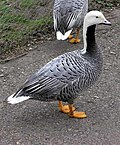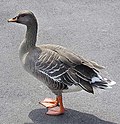Anser (bird)
| Anser | |
|---|---|

| |
| Greylag geese (pair), Anser anser | |
| Scientific classification | |
| Kingdom: | Animalia |
| Phylum: | Chordata |
| Class: | Aves |
| Order: | Anseriformes |
| Family: | Anatidae |
| Tribe: | Anserini Vigors 1825 |
| Genus: | Anser Brisson, 1760 |
| Type species | |
| Anser anser Greylag goose | |
| Species | |
and see text | |
| Synonyms | |
|
Chen Boie, 1822 (but see text) | |
The waterfowl genus Anser includes the grey geese and the white geese. It belongs to the true geese and swan subfamily (Anserinae). The genus has a Holarctic distribution, with at least one species breeding in any open, wet habitats in the subarctic and cool temperate regions of the Northern Hemisphere in summer. Some also breed further south, reaching into warm temperate regions. They mostly migrate south in winter, typically to regions in the temperate zone between the January 0 °C (32 °F) to 5 °C (41 °F) isotherms.
The genus contains 11 living species, which span nearly the whole range of true goose shapes and sizes. The largest is the greylag goose at 2.5–4.1 kg (5.5–9.0 lb). All have legs and feet that are pink, or orange, and bills that are pink, orange, or black. All have white under- and upper-tail coverts, and several have some extent of white on their heads. The neck, body and wings are grey or white, with black or blackish primary—and also often secondary—remiges (pinions). The three species of "white geese" (emperor, snow and Ross's geese) were formerly treated as a separate genus Chen, but are now generally included in Anser. The closely related "black" geese in the genus Branta differ in having black legs, and generally darker body plumage.[1]
Systematics, taxonomy and evolution[]
The genus Anser was introduced by the French zoologist Mathurin Jacques Brisson in 1760.[2] The name was derived by tautonymy from the specific epithet of the greylag goose Anas anser introduced by Linnaeus in 1758.[3][4] Anser is the Latin word for "goose".[5]
Phylogeny[]
The evolutionary relationships between Anser geese have been difficult to resolve because of their rapid radiation during the Pleistocene and frequent hybridization.[6][7] In 2016 Ottenburghs and colleagues published a study that established the phylogenetic relationships between the species by comparing exonic DNA sequences.[8]
| Anser |
| ||||||||||||||||||||||||||||||||||||||||||||||||||||||||||||
Species[]
The genus contains 11 species:[9]
| Image | Scientific name | Common name | Distribution |
|---|---|---|---|
 |
Anser indicus | Bar-headed goose | Central Asia |
 |
Anser canagicus | Emperor goose | the Aleutian Islands, Alaska |
 |
Anser rossii | Ross's goose | North America |
 |
Anser caerulescens | Snow goose | North America |
 |
Anser anser | Greylag goose | Western Europe, Iceland, Norway, Sweden, Finland, the Baltic States, northern Russia, Poland, eastern Hungary and Romania |
 |
Anser cygnoides | Swan goose | inland Mongolia, northernmost China, and southeastern Russia |
 |
Anser fabalis | Taiga bean goose | northern Europe and Asia |
 |
Anser brachyrhynchus | Pink-footed goose | northwestern Europe, especially Ireland, Great Britain, the Netherlands and western Denmark |
 |
Anser serrirostris | Tundra bean goose | northern Siberia |
 |
Anser albifrons | Greater white-fronted goose | North America, east of Siberia east to Arctic Canada, wintering in the United States and Japan |
 |
Anser erythropus | Lesser white-fronted goose | northernmost Asia, but a scarce breeder in Europe |
The following white geese were separated as the genus Chen. Most ornithological works now include Chen within Anser,[10][11][12][13]
- Snow goose, Anser caerulescens
- Ross's goose, Anser rossii
- Emperor goose, Anser canagicus – sometimes separated in Philacte
Some authorities also treat some subspecies as distinct species (notably the tundra bean goose[14][15]) or as likely future species splits (notably the Greenland white-fronted goose).[16]
Fossil record[]
Numerous fossil species have been allocated to this genus. As the true geese are near-impossible to assign osteologically to genus, this must be viewed with caution. It can be assumed with limited certainty that European fossils from known inland sites belong into Anser. As species related to the Canada goose have been described from the Late Miocene onwards in North America too, sometimes from the same localities as the presumed grey geese, it casts serious doubt on the correct generic assignment of the supposed North American fossil geese.[17][18][19] Heterochen = Anser pratensis seems to differ profoundly from other species of Anser and might be placed into a different genus; alternatively, it might have been a unique example of a grey goose adapted for perching in trees.[a][b]
- † (Middle/Late Miocene of Bavaria, Germany) – sometimes in Cygnus
- † Bickart 1990 (Big Sandy Late Miocene of Wickieup, USA)
- † Bickart 1990 (Big Sandy Late Miocene of Wickieup, USA)
- † (Late Miocene of Steinheim, Germany)
- † (Meyer 1865) Milne-Edwards 1867b [Anas oeningensis Meyer 1865] (Late Miocene of Oehningen, Switzerland)
- † Burchak-Abramovich & Nikolov 1984 (Late Miocene/Early Pliocene of Trojanovo, Bulgaria)
- † (Short 1970) [Heterochen pratensis Short 1970] (Valentine Early Pliocene of Brown County, USA)
- † (Brodkorb 1964) [Chen pressa Brodkorb 1964] (Dwarf Snow goose) (Glenns Ferry Late Pliocene of Hagerman, USA)
- † Martin & Mengel 1980 (Pliocene of Nebraska)
- † (Early? Pleistocene of Binagady, Azerbaijan)
- † Kuročkin 1971
- † Burchak-Abramovich & Gadzyev 1978
- † Kuročkin 1985
- †Anser djuktaiensis Zelenkov & Kurochkin 2014 (Late Pleistocene of Yakutia, Russia)
The Maltese swan Cygnus equitum was occasionally placed into Anser, and Anser condoni is a synonym of Cygnus paloregonus.[17] A goose fossil from the Early-Middle Pleistocene of El Salvador is highly similar to Anser.[20] Given its age it is likely to belong to an extant genus, and biogeography indicates Branta as other likely candidate.
Beneden 1872 nomen nudum (Late Miocene of Antwerp, Belgium) may be a shelduck.
Relationship with humans and conservation status[]
Two species in the genus are of major commercial importance, having been domesticated as poultry: European domesticated geese are derived from the greylag goose, and Chinese and some African domesticated geese are derived from the swan goose.
Most species are hunted to a greater or lesser extent; in some areas, some populations are endangered by over-hunting. Most notably, the lesser white-fronted goose is listed by IUCN Red List as Vulnerable throughout its range, and due to overhunting and rampant habitat destruction, the population of the swan goose is on the verge of collapsing, leading to a listing as Endangered.[21]
Other species have benefited from reductions in hunting since the late 19th and early 20th centuries, with most species in western Europe and North America showing marked increases in response to protection[citation needed]. In some cases, this has led to conflicts with farming, when large flocks of geese graze crops in the winter.[citation needed]
See also[]
- List of recently extinct birds
- Late Quaternary prehistoric birds
- List of fossil bird genera
Notes[]
| Wikimedia Commons has media related to Anser. |
- ^ Short (1970) considers this bird to be somewhat reminiscent of geese and swans, shelducks, and the or "perching ducks".
- ^ The or "perching ducks" are now known to be a paraphyletic assemblage of miscellaneous waterfowl whose morphological similarities are the product of convergent evolution towards being able to perch in trees (Livezey 1986).
References[]
- ^ Carboneras, Carles (1992): Family Anatidae (Ducks, Geese and Swans). In: del Hoyo, Josep; Elliott, Andrew & Sargatal, Jordi (eds.): Handbook of Birds of the World (Volume 1: Ostrich to Ducks): 536–629, plates 40–50. Lynx Edicions, Barcelona. ISBN 84-87334-10-5
- ^ Brisson, Mathurin Jacques (1760). Ornithologie, ou, Méthode Contenant la Division des Oiseaux en Ordres, Sections, Genres, Especes & leurs Variétés (in French and Latin). Paris: Jean-Baptiste Bauche. Vol. 1, p. 58, Vol. 6, p. 261.
- ^ Mayr, Ernst; Cottrell, G. William, eds. (1979). Check-list of Birds of the World. Volume 1 (2nd ed.). Cambridge, Massachusetts: Museum of Comparative Zoology. p. 424.
|volume=has extra text (help) - ^ Linnaeus, Carl (1758). Systema Naturæ per regna tria naturae, secundum classes, ordines, genera, species, cum characteribus, differentiis, synonymis, locis, Volume 1 (in Latin) (10th ed.). Holmiae:Laurentii Salvii. p. 123.
- ^ Jobling, James A (2010). The Helm Dictionary of Scientific Bird Names. London: Christopher Helm. p. 48. ISBN 978-1-4081-2501-4.
- ^ Ottenburghs, Jente; van Hooft, Pim; van Wieren, Sipke E.; Ydenberg, Ronald C.; Prins, Herbert H. T. (2016). "Hybridization in geese: a review". Frontiers in Zoology. 13 (1): 20. doi:10.1186/s12983-016-0153-1. PMC 4866292. PMID 27182276.
- ^ Ottenburghs, Jente; Megens, Hendrik-Jan; Kraus, Robert H. S.; van Hooft, Pim; van Wieren, Sipke E.; Crooijmans, Richard P. M. A.; Ydenberg, Ronald C.; Groenen, Martien A. M.; Prins, Herbert H. T. (2017). "A history of hybrids? Genomic patterns of introgression in the True Geese". BMC Evolutionary Biology. 17 (201): 1–14. doi:10.1186/s12862-017-1048-2. PMC 5568201. PMID 28830337.
- ^ Ottenburghs, J.; Megens, H.-J.; Kraus, R.H.S.; Madsen, O.; van Hooft, P.; van Wieren, S.E.; Crooijmans, R.P.M.A.; Ydenberg, R.C.; Groenen, M.A.M.; Prins, H.H.T. (2016). "A tree of geese: A phylogenomic perspective on the evolutionary history of True Geese". Molecular Phylogenetics and Evolution. 101: 303–313. doi:10.1016/j.ympev.2016.05.021. PMID 27233434.
- ^ Gill, Frank; Donsker, David, eds. (2019). "Screamers, ducks, geese, swans". World Bird List Version 9.1. International Ornithologists' Union. Retrieved 2 April 2019.
- ^ Cramp, S. (1977): The Birds of the Western Palearctic. Oxford. ISBN 0-19-857358-8
- ^ Madge, Steve & Burn, Hilary (1987): Wildfowl : an identification guide to the ducks, geese and swans of the world. Christopher Helm, London. ISBN 0-7470-2201-1
- ^ Dudley, Steve P.; Gee, Mike; Kehoe, Chris; Melling, Tim M.; The British Ornithologists' Union Records Committee (2006). "The British List: A Checklist of Birds of Britain (7th edition)" (PDF). Ibis. 148 (3): 526–563. doi:10.1111/j.1474-919X.2006.00603.x.
- ^ American Ornithologists' Union (1998): Check-list of North American Birds: the species of birds of North America from the Arctic through Panama, including the West Indies and Hawaiian Islands Archived 2007-12-11 at the Wayback Machine (7th ed., 41st supplement). American Ornithologists' Union and Allen Press, Washington, D.C. and Lawrence, Kansas, USA. ISBN 1-891276-00-X
- ^ Banks, Richard C.; Chesser, R. Terry; Cicero, Carla; Dunn, Jon L.; Kratter, Andrew W.; Lovette, Irby J.; Rasmussen, Pamela C.; Remsen, J.V. Jr; Rising, James D.; Stotz, Douglas F. (2007). "Forty-eighth Supplement to the American Ornithologists' Union Check-List of North American Birds" (PDF). Auk. 124 (3): 1109–1115. doi:10.1642/0004-8038(2007)124[1109:FSTTAO]2.0.CO;2.
- ^ van den Berg, Arnoud B. (2007): Lijst van Nederlandse vogelsoorten ["List of Dutch bird taxa]. [Dutch and English] PDF fulltext Archived September 29, 2007, at the Wayback Machine
- ^ Fox, A.D.; Stroud, D.A. (2002). "Greenland White-fronted Goose". Birds of the Western Palearctic Update. 4 (2): 65–88.
- ^ Jump up to: a b Brodkorb, Pierce (1964). "Catalogue of Fossil Birds: Part 2 (Anseriformes through Galliformes)". Bulletin of the Florida State Museum. 8 (3): 195–335.
- ^ Short, Lester L. (1970). "A new anseriform genus and species from the Nebraska Pliocene" (PDF). Auk. 87 (3): 537–543. doi:10.2307/4083796. JSTOR 4083796.
- ^ Livezey, Bradley C. (1986). "A phylogenetic analysis of recent anseriform genera using morphological characters" (PDF). Auk. 103 (4): 737–754. doi:10.1093/auk/103.4.737.
- ^ A left humerus (specimen 2SSAP30-853) and a left clavicle (specimen MUHNES 2SSAP30-545), apparently of a single bird: Cisneros, Juan Carlos (2005). "New Pleistocene vertebrate fauna from El Salvador". Revista Brasileira de Paleontologia. 8 (3): 239–255. doi:10.4072/rbp.2005.3.09.
- ^ IUCN (2007): 2007 IUCN Red List of Threatened Species Archived June 27, 2014, at the Wayback Machine.
- Anser (bird)
- Geese
- Bird genera
- Taxa named by Mathurin Jacques Brisson